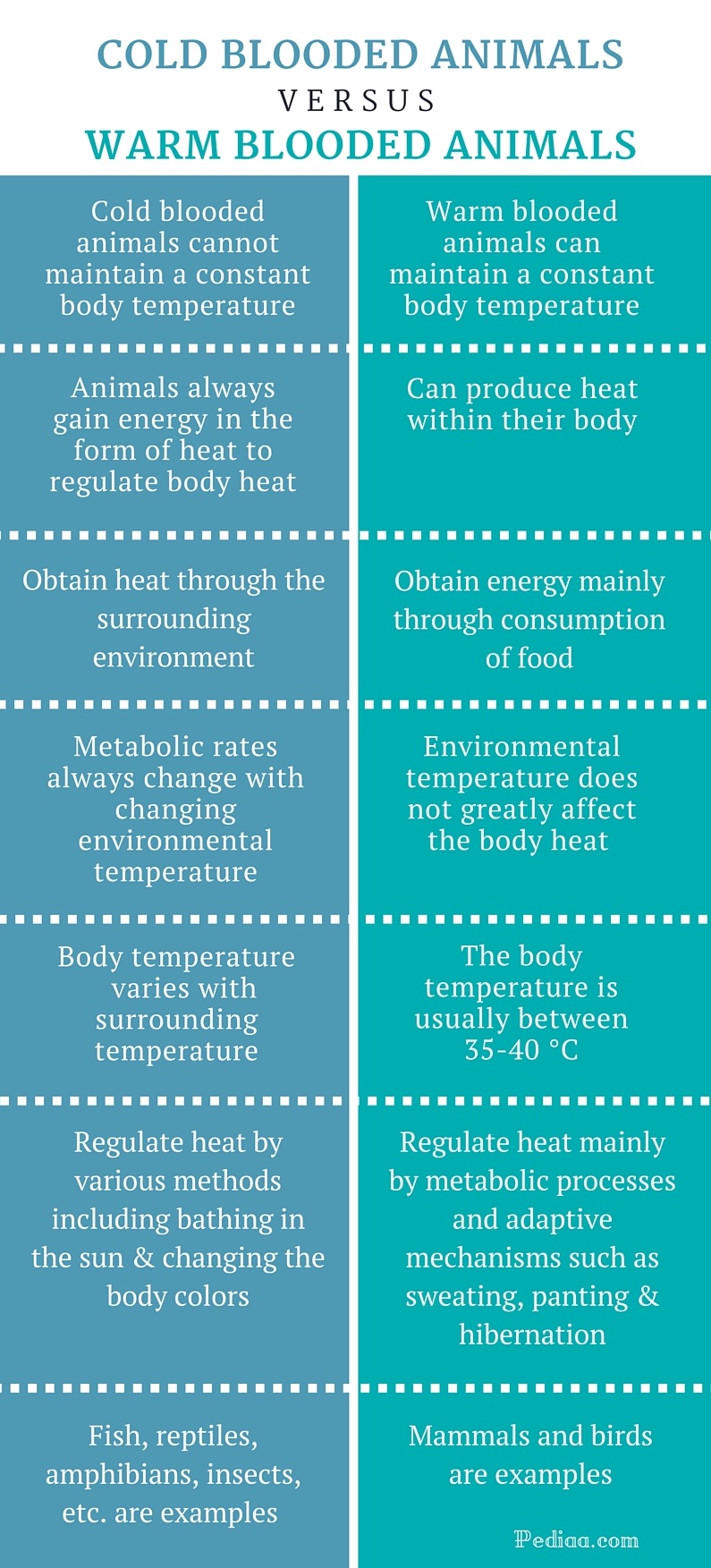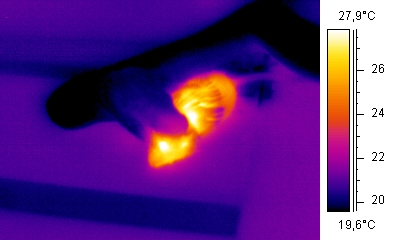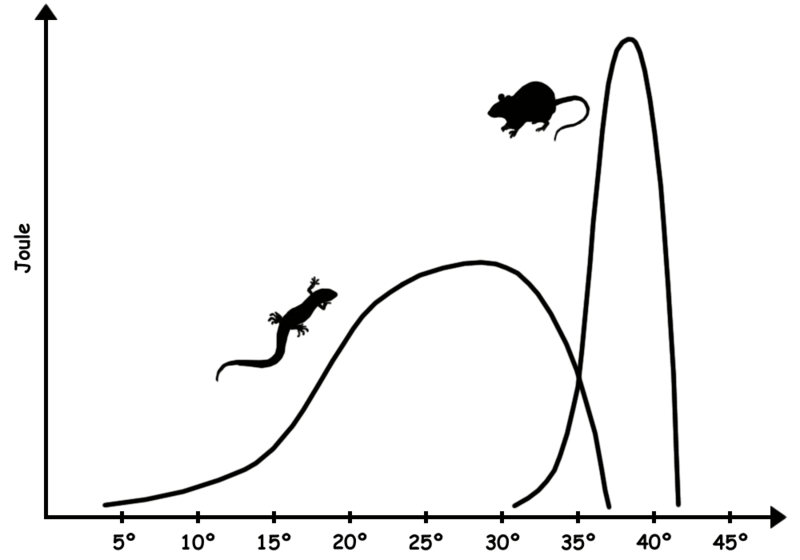What Is The Difference Between Warm And Cold Blooded Animals
Main Departure – Cold Blooded vs Warm Blooded Animals
Organisms can be classified into 2 broad categories based on the ability to regulate trunk temperature with the surrounding temperature: these two categories are common cold-blooded (ectotherms) and warm-blooded (endotherms) animals. The main departure betwixt cold blooded and warm blooded animals is that the cold-blooded animals cannot maintain a abiding body temperature, whereas warm-blooded animals can maintain a constant torso temperature. Considering of this reason, their body shows various adaptations to regulate temperature with respect to their surrounding temperature. The difference between cold and warm blooded animals will be discussed in more particular in this commodity.
What are Cold Blooded Animals
Cold-blooded animals or ectotherms are the organisms that regulate their temperature at a abiding level with the changes in the surrounding temperature. The activities of these creatures are greatly affected by the surrounding temperature since the metabolic rate depends directly on the body temperature. Generally, activeness decreases when the surrounding temperature decreases and vice versa. Metabolic rate is mainly regulated by oestrus or energy gain from the environment rather than by free energy generated inside their body. Because of this reason, most of the cold-blooded animals are found in warm habitats. Animals that live in cold habitats are usually sluggish. Common cold-blooded animals show various adaptations to increase their body temperature, such as bathing in the sunday, irresolute the body colors, stretching out limbs nether sunlight, etc. During the very cold season, cold blooded animals become very inactive. For example, certain frog species and salamanders do not motility during the winter season, and nearly insects practise not wing until the temperature of the flight muscles increases to an optimum temperature. Many animals, specially the vertebrates such as amphibians, reptiles and fish are common cold-blooded animals.

Thermographic prototype of a serpent (common cold blooded) eating a mouse (warm blooded)
What are Warm Blooded Animals
Warm-blooded animals are also known as endotherms, which means that they can produce their own torso temperature despite the environmental temperature changes. They maintain a constant body temperature betwixt 35 – twoscore °C mainly by metabolic processes and adaptive mechanisms such every bit sweating, panting, insulation, regulation of blood flow to extremities, migration, hibernation, burrowing, irresolute the body surface surface area to trunk volume ratio, etc. Considering of these mechanisms,warm blooded animals are extremely adaptive and tin can live within a wide range of environmental temperatures from freezing arctic to hottest deserts. Therefore, warm-blooded animals are found nearly all the habitats in the earth. Mammals and birds are the only groups of warm-blooded animals. When compared to cold-blooded animals, warm-blooded animals accept very loftier free energy expenditure due to their high metabolic rates.

Sustained energy output of a warm blooded animal (mammal) and a common cold blooded animal (reptile) every bit a function of cadre temperature
Difference Between Cold Blooded and Warm Blooded Animals
Definition
Cold blooded animals: Cold blooded animals cannot maintain a abiding trunk temperature.
Warm blooded animals: Warm blooded animals tin maintain a constant body temperature.
Energy Product
Common cold blooded animals: Cold blooded animals always gain free energy in the form of heat to regulate body heat.
Warm blooded animals: Warm blooded animals can produce heat within their body.
Rut Source
Cold blooded animals: Cold blooded animals obtain oestrus through the surrounding surroundings.
Warm blooded animals: Warm blooded animals generate heat mainly through consumption of food.
Metabolic Rates
Cold blooded animals: The metabolic rates of cold blooded animals always change with irresolute ecology temperature. Metabolic rates of cold-blooded animals are commonly depression than that of warm-blooded animals.
Warm blooded animals:In general, ecology temperature does not profoundly affect the body heat of warm-blooded animals.
Body Temperature
Common cold blooded animals: The body temperature of cold blooded animals varies with surrounding temperature.
Warm blooded animals: The body temperature of warm-blooded animals is usually betwixt 35-40 °C.
Rut Regulation
Common cold blooded animals: Cold-blooded animals regulate oestrus by various methods including bathing in the sun, changing the trunk colors, stretching out limbs under sunlight, etc.
Warm blooded animals: Warm-blooded animals regulate heat mainly by metabolic processes and adaptive mechanisms such as sweating, panting, insulation, regulation of blood menses to extremities, migration, nocturnally agile, hibernation, burrowing, changing the torso surface area to torso volume ratio, etc.
Examples
Cold blooded animals: Fish, reptiles, amphibians, insects, etc. are examples of common cold blooded animals.
Warm-blooded animals:Mammals and birds are examples of warm blooded animals.
Image Courtesy:
"Wiki snake eats mouse" Past Arno / Coen – www.nutscode.com (CC Past-SA 3.0) Commons Wikimedia
"Homeothermy-poikilothermy" By Petter Bøckman – Own work (Public Domain) via Eatables Wikimedia

Source: https://pediaa.com/difference-between-cold-blooded-and-warm-blooded-animals/
Posted by: crosslond1967.blogspot.com

0 Response to "What Is The Difference Between Warm And Cold Blooded Animals"
Post a Comment